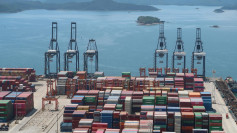The National Health Commission stated on Tuesday that mainland China reported 1,038 new coronavirus cases for Monday, of which 307 were symptomatic and 731 were asymptomatic.
This contrasts with 810 new cases a day earlier, of which China separately counts 570 asymptomatic infections and 240 symptomatic infections. Shanghai reported no new local symptomatic cases, compared to one the day before, and three new local asymptomatic cases, the same as the day before.
As of Oct. 3, officials have kept COVID-19 controls in place in some areas of Shenzhen, China. In dangerous locations, localized disruptions are likely.
Authorities in Guangdong Province are still enforcing COVID-19 regulations in Shenzhen. Officials have categorized certain sections in the Longgang, Luohu, and Nanshan districts as medium- or high-risk, and lockdown procedures are still in place in the impacted areas. Residents and people must stay in their houses; exceptions may be made in case of emergency or for vital purposes.
Travel to and from the impacted communities is restricted by officials. In the impacted districts, all entertainment establishments are still closed. After the most recent verified community case, authorities maintain safeguards for three days and continue testing before lifting restrictions.
In low-risk neighborhoods and regions of the city, the government does not classify mobility or company operations. Metro services are back in operation, although the affected stations are still closed.
According to a statement released on Tuesday by the city's leading COVID-19 advocacy group, Lhasa, the capital of the Tibet autonomous region, started to gradually restore the economy and return people's lives to normal on Tuesday. This was done under the presumption of continuing pandemic prevention and control measures.
The COVID-19 outbreak that started in Lhasa in early August has been successfully contained. On Monday, health officials said it identified 16 locally confirmed COVID-19 cases and 149 symptomatic carriers. All of the instances were found in the quarantined individuals.
In Chengdu, Sichuan province, which has been dealing with a COVID-19 outbreak since August 25, life is starting to return to normal. The Chengdu Epidemic Prevention and Control Headquarters announced in a notification on Sunday that the city would return to normal on Monday as the most recent COVID outbreak subsided. Governmental businesses and offices would reopen, and automobiles would operate without further permission.
The warning stated that anyone accessing residential communities, public spaces, or using public transit must possess a COVID-19 test result that was negative and received within 72 hours.
Under the premise of strictly enforcing the policy of letting a small number of people who have made reservations in advance, outdoor scenic spots, cultural centers, libraries, museums, and art galleries in the city will be opened in an orderly manner.






